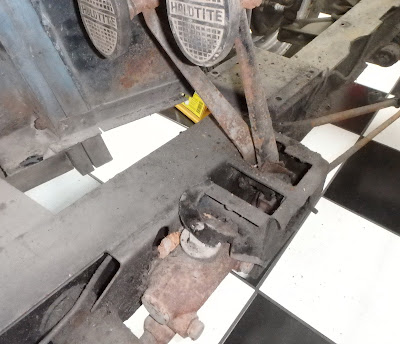PROJECT 51: Front suspension and brakes. As I mentioned
earlier, there is strong evidence that the front suspension of the MG had been
worked on in the past … and that Brutus had done the work.
When the MG "T-series" went from the TC to the TD,
one of the many things that got upgraded was the front suspension. The TC had a
solid front axle (like a Model-T Ford), which was changed to independent,
coil-spring suspension for the TD. It makes for a much smoother ride and far
better handling. It is also equipped with rack-and-pinion steering, as opposed
to the TC's lever-and-tie-rod arrangement. One of the unusual things in the new
suspension is that the shock absorber IS the upper A-arm.
Although neither of the coil springs was broken, one was a
little deformed, and they were not equal heights, so I decided to replace them.
When compared to the new ones, it turns out they had fatigued and compressed
somewhat over the years. (I know the feeling!)
I was able to make use of my yard-sale pullers, once again,
to get the brake drums off the spindles, and the bearings out of the drums. I
have all new bearings to put back in (as any sane restorer would do), but those
that I took out were in pretty good shape. Because the set from the right wheel
had part numbers etched into them, and the left did not, I suspect that the
rights had been replaced, and the lefts may be original (or replaced at a
different time). Unlike most modern cars that use tapered roller-bearings, the
MG uses caged ball-bearings.
One of the "Brutus was here!" signs was that the
bearings and the entire hubs were packed chock full of grease. This is one of
those "If a little is good, a lot must be better," misconceptions.
The only grease that helps the bearings is what is inside the races and in
contact with the balls or rollers. The fallacy seems to be that if the bearing
gets hot and the grease melts out, the fresh grease will flow in to take its
place and save the bearing. The reality is that if the bearing gets so hot that
it melts (actually burns) the hi-temp bearing grease you are about thirty
seconds away from a seized and spun bearing. And the adjacent grease is going
to stay right where you packed it. In fact, it actually prevents some of the
heat in the normal-running bearing from dissipating.
The brake shoes still had a good deal of lining material,
and I suspect they were fairly new when the car went into its 17-year storage.
They had a lot of surface rust, but that could be easily sandblasted away, and
they almost looked like they could be reused. That is until one of the linings
fell off in my hand!
After cleaning and sandblasting the brake drums, I
discovered that what I thought (hoped) was mild surface rust on the inside
braking surfaces was, in fact, deep-rooted Washington State
corrosion. (Which I believe is also the state flower; I know it grows
everywhere up there!) The pitting that the corrosion left behind was far too
deep for sanding out, as I had hoped, so all four drums went out to AZ Brake &
Clutch to be turned. At $17 each, another no-brainer!
The wheel cylinders were badly corroded, and I doubt that
they would have pushed the brake shoes, but I have six new cylinders (more
gifts from Santa) ready to install. Each front wheel gets two cylinders.
I'm in the process of cleaning, sandblasting, and painting all
of the parts, and will hopefully have everything ready to start reassembling
when the frame comes back from powder-coating in a week or so.
 |
The TD's "Better Idea" independent front
suspension with rack and pinion steering. |
 |
| Old vs. New front springs. |
 |
Shock absorber/upper A-arm is at right.
Not the steel brake line connecting the two
wheel cylinders. |
 |
Old yard-sale friend pressed into service
again to pull the drums. |
 |
| Friend number-2 pulling the outer wheel bearing. |
 |
| New caged ball bearing. |
 |
"Brutus was here!" glob of grease scooped
out of bearing spindle. |
 |
Rusty brake shoes and corroded
wheel cylinders. |
 |
More than skin-deep rust requiring
that the drums be turned. |
 |
| Lining delaminated from the steel shoe. |
 |
Old and New wheel cylinders.
At right are the rear wheel cylinders
with the emergency-brake lever. |












































